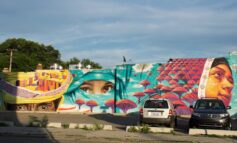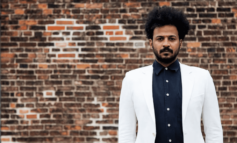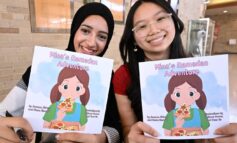Muslims have a long and rich history in Greater Detroit, but it has not been thoroughly documented – until now. Dr. Sally Howell brings this history to life in her new book, “Old Islam in Detroit: Rediscovering the Muslim American Past” (Oxford University Press, 2014). In her book, she intends to “lay groundwork for a new interpretation of the Muslim American past that makes sense of the tactical amnesias, persistent discontinuities, and narrative breaks that have kept crucial aspects of the history of Islam in America from being remembered and effectively understood.”
Howell is assistant professor of History and Arab American Studies at the University of Michigan-Dearborn. She is an editor of “Arab Detroit 9/11: Life in the Terror Decade” (Wayne State University Press, 2011) and “Citizenship and Crisis: Arab Detroit after 9/11” (Russell Sage Foundation Press, 2009). She is also a contributor to “The Cambridge Companion to American Islam” (Cambridge University Press, 2013), edited by Omid Safi and Juliane Hammer.
How did you become interested in the early history of Muslims in Greater Detroit?
In 2004, when I first surveyed the city’s mosques, I was struck by the contrast between African American Muslims, who were eager to share their past, especially early narratives about the Nation of Islam and the other Muslim groups in the city, mostly Arab and South Asian, who seemed not to know about their past or did not want to dwell on it, even though their history in Detroit went further back in time. Just a little detective work showed me that the presence of Muslims in Detroit in the early 20th century was rich indeed. The nation’s first purpose-built mosque opened in Highland Park in 1921, and the city was already well known as a center of Muslim American life and activism before WWI. Why do Muslims today know so little about this early period? That was the question that drove my initial interest; but I also became curious about why immigrant and Black American narratives seemed rarely to overlap, why some groups, like early African American Sunnis, were left out of the history altogether; and why the new, post-1965 immigration compelled a sort of “reset” in the way this past is remembered.
What drew Muslim immigrants to Detroit in the early twentieth century?
Detroit was a boom town in the first decades of the 20th century. Muslims were drawn here like everyone else, by the invention of the moving assembly line in Ford’s factories and the myriad opportunities the auto-driven economy created; foremost among them was the promise of a $5 work day. News of the mutual aid societies, anti-colonial political clubs, mosques, and other associations opened in the 1910s and 1920s by local Arabs, Turks, Kurds, Albanians, and Indians brought more Muslims to Detroit, especially religious leaders, missionaries, and those with spouses and children. African Americans from the Deep South also came to Detroit in this period and lived and worked alongside immigrant Muslims. The Nation of Islam was established here in the 1930s and the Ahmadiyya and Sunni traditions also won Black converts.
What challenges did Detroit Muslims face in the early twentieth century? Are today’s Muslims in Detroit facing similar challenges?
Most Muslims were denied the right to immigrate and naturalize by the racial exclusions laws and immigration quotas put in place in the late 19th and early 20th centuries. For those who were allowed in, mostly those from the westernmost provinces of the Ottoman Empire, the challenges they faced involved figuring out how to practice Islam in a Christian-majority society. Each generation has needed to establish and sustain mosques, to raise their children as Muslims, to find suitable spouses, to identify and support religious leaders, and to explain Islam and make room for Islamic traditions in a society with deep-seated suspicions about the faith.
Most of these goals are easier to accomplish in Detroit today because the region is now home to so many Muslims; to large, well-known Muslim enclaves; and to hundreds of Muslim businesses and institutions. Halal food is ubiquitous in the area; many public schools close for Islamic holidays; and Muslims are key players in the region’s political, economic, and cultural life. This robust visibility has its drawbacks, however, making Detroit’s Muslims vulnerable in the post-9/11 period in ways that would have been unimaginable in the past. In recent years they have faced intense harassment by Islamophobes and Qur’an-burners and they have been targeted by several federal agencies.
What role did Detroit Muslims play in shaping “Muslim American identity”?
A huge role. In the first place, the Nation of Islam was established in Detroit and Detroit was the first American home of the Ahmadiyya movement. Over time, these groups led tens of thousands of African Americans toward more mainstream variants of Islam and introduced the faith and its American practice to millions more. Several of the nation’s first and oldest mosques were built in Detroit by Albanian, Turkish, Arab, and South Asian immigrants. North America’s first pan-Muslim association – the Federation of Islamic Associations of the US and Canada – was virtually led from Detroit in the 1950s-1980s.
Together, Detroit’s Muslims developed a comfortable means of practicing Islam in the American Midwest and they actively promoted this praxis nationwide. When the arrival of new immigrants began in 1965, Detroit’s established Muslim institutions welcomed them, but the newcomers were often deeply disturbed by the American Muslim identities and practices they encountered in Detroit.
What is the difference between “old Islam” and “new Islam” in Detroit?
This depends on whom you ask and when. Islam, like many other religions, exists both in received textual forms and as a lived tradition. For many Muslims, the only legitimate form of religious praxis is the very oldest – that practiced by the Prophet Muhammad himself. For others, the example of the Prophet is used more as a metaphor. This adaptability has enabled Islam to travel widely.
For individuals, the experience of migration to the West (like that of conversion to Islam), encourages a more intentional, reflexive focus on religion. Migrants/converts must learn to “do for self” things taken for granted in more established, Muslim-majority settings, and their means of doing so have shifted significantly over time. In Detroit, this process is complicated by the arrival of ever newer migrants/converts, who are caught between their own understandings of Islamic praxis and those of their predecessors in the city. Frequently, the newcomers see themselves as reformers. They argue that existing Muslim American praxis is weak, insufficient, and corrupt. The new praxis they promote (which is usually described as a return to prophetic tradition) is deployed against a seemingly old praxis (which is actually new in its American setting). In other words, when people criticize forms of Muslim belief and practice that have developed in Detroit over many decades, what they are actually criticizing is the reality and the possibility of an Americanized Islam. I hope my book illustrates that the (frequently painful) ruptures created by these encounters between already American Muslims and new American Muslims go much further back in time than the 1970s and are in fact enduring, transformative features of American Islam itself.
Joseph Richard Preville is an American writer living in Nizwa, Oman. His work has appeared in The Christian Science Monitor, San Francisco Chronicle, Harvard Divinity Bulletin, Tikkun, The Jerusalem Post, Muscat Daily, Turkey Agenda and Saudi Gazette. He is also a regular contributor to ISLAMiCommentary.
-Julie Poucher Harbin is Editor of ISLAMiCommentary.
-This article, which originally appeared at ISLAMICommentary.org, has been edited for space and style.





Leave a Reply